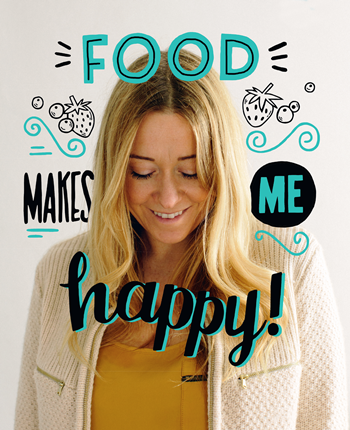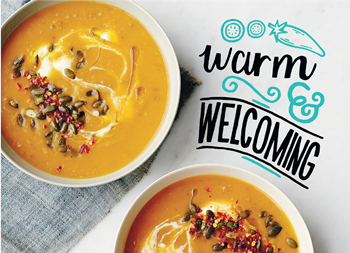Anna Jones: a zest for life
Anna Jones is a chef and author who trained under Jamie Oliver. We spoke to her about the joy she’s found in food and her top recipes for outdoor meals and busy unit meetings
 How did your food career begin?
How did your food career begin?
I wasn’t very happy at work – I felt that I was just drifting along and, to be truthful, it made me a little lazy and disconnected! So when I read an article about how you should choose a job based on which pages of the papers you read first (in my case, the restaurant section), it sparked something.
I searched online for cooking courses and Jamie Oliver’s Fifteen apprentice programme came up. I applied and, just 10 days later, my hobby became my work. That was about 14 years ago. I’m so glad I followed my instinct and took that leap of faith.
What made you decide to strike out by yourself after working for Jamie?
Once I was doing something I was passionate about, I found that the energy and ambition came naturally. My parents instilled in me the idea that anything is achievable, so I try to do the same with young people who I meet within the industry. It also helps that the Fifteen team were so nurturing. I had the opportunity to try my hand at lots of things and realised that the combination of cooking, food styling and writing would suit me better in the long term than the crazy hours and intense atmosphere of professional kitchens.
You’ve worked in a few all-male kitchen environments – was that daunting?
In Tuscany, where I did some of my training, I worked with all-male teams who were warm and welcoming. It may be that the huge respect Italians have for ‘Nonna’s’ [grandmother’s] cooking and for food in general seeps into the culture. But then in other places, I must admit, I didn’t enjoy that old-school, macho attitude that still exists. Why say ‘Yes, Chef’ when you could use a person’s name? I’m grateful for those experiences though because they taught me what I feel is acceptable in terms of how I’m treated – and to stand up for myself. Obviously, both men and women can be wonderful chefs, but there’s something about the act of cooking – the generosity and sensitivity – that feels somehow feminine to me.
As a female-only organisation, how can we encourage girls and young women to feel positive about food and their bodies?
With so many contradicting messages about what is or isn’t good for you, it can be hard for girls to navigate the world of food. There’s also an information overload of books with very specific promises, like eating for concentration or weight loss or improved sleep. Also, while the ‘clean eating’ movement has some sound principles, it can feel restrictive – I recently met a woman who was incredibly stressed out because she couldn’t find spirulina powder where she lived! I think we need to reframe the conversation and avoid talk of diet or dieting. We need to simplify and reconnect with the idea of food as fuel – the very thing that allows us to function.
Encouraging girls to shop, cook, pick or even grow their own food is key to creating a healthy respect and appreciation for what they put in their bodies. Making and eating meals together is also important, as it reinforces that food is fun. Eating is about celebration, joy and sharing. It provides us with social as well as physical nourishment.
Tell us about your recipes for our members.
Even though I spend my life cooking, I often don’t take as much time as I would like to make sure I am really well-nourished. Some weeks I’m saintly; I get into a rhythm and make breakfasts, lunches and dinners to be proud of. Other weeks I don’t do so well. It’s in those weeks that I try to make a pot of soup. This recipe is fab for batch cooking as it’s simple and provides eight servings of easy goodness. The fruit bars are great to make for, or with, girls if some of them have intolerances or allergies, as they’re free from eggs and dairy, and gluten-free if you use the right flour. You can read my recipes below.
A great snack for unit meetings and trips
These bars have scarlet and vibrant pink summer fruit topped off with a crunchy crumble topping. You can vary the fruits depending on the time of year: blackberries and apples are also great – especially if you can take your girls fruit picking. Those of you following guiding in countries outside the UK will have plenty of different seasonal fruits to try too – feel free to experiment!
Makes 20 bars
- 150g coconut oil or butter, plus extra for greasing
- 150g rolled oats
- 150g spelt flour
- 150g coconut sugar or unrefined light brown sugar, plus 1 extra tablespoon
- 250g rhubarb (about 2 medium sticks)
- 300g strawberries, hulled
- The juice of 1 lemon
Preheat your oven to 210°C (190°C fan/gas 7), then roughly line a 30x20cm baking tray with greaseproof paper and rub with a little coconut oil or butter.
Put the coconut oil or butter into a large saucepan over a medium heat and leave to melt, then take off the heat.
Add the oats, flour, 150g sugar and a pinch of salt and give it a good mix. Take out 6 tablespoons of the mixture and put to one side for the topping. Press the rest of the mixture into the bottom of the baking tray with the back of a spoon until it evenly coats the entire area.
Chop the rhubarb and the strawberries quite finely and put into a bowl; squeeze over the lemon juice, add the extra tablespoon of sugar and toss to coat. Scatter the fruit over the crumb base then sprinkle with the reserved topping.
Bake for 40 minutes, until the fruit is bubbly and the crumbs are golden.
Let the bars cool in the tray, then cut into roughly 20 pieces. Keep them stored in the fridge and they’ll last for four to five days.
Great for camping
This soup is simple and nourishing, and would be great for a camp meal: take a big container-full along and heat through gently. You could also put in a tin of cannellini beans to help bulk it out and add extra texture. It’s made from sweet potatoes and squash, which are good sources of healthy carbohydrates (the kind our bodies love!), and are packed with beta-carotene and vitamins. I add fennel seeds, which help with digestion, plus a little chilli for warmth and to boost the metabolism.
Serves 8 
- 1 leek
- 1 red onion
- 2 carrots
- 2 sticks of celery
- 2 medium sweet potatoes
- 1 medium butternut squash
- 1 tablespoon fennel seeds
- 1 tablespoon Turkish chilli or a good pinch of red chilli flakes
- 1 tablespoon vegetable stock powder or 1 stock cube
- Olive or coconut oil
Fill and boil a kettle and get all your ingredients together. Get your biggest pot – if you don’t have a big enough pot, two smaller ones will do.
Wash and finely slice the leek, onion, carrots and celery. Heat a large pan on a medium heat and add a little olive or coconut oil. Once the pan is hot, add the chopped veg and cook for 10-15 minutes, until soft and sweet.
Meanwhile, peel the sweet potatoes and chop into large chunks. De-seed the squash and roughly chop into similar-sized chunks (I leave the skin on but, if you like, you could peel this too).
Once the vegetables are soft and smelling good, add the sweet potatoes, squash and spices along with 2 litres of hot water from the kettle and the stock powder or cube.
Bring to the boil, then turn down to a simmer and cook for 30-40 minutes, until the vegetables are soft and falling apart, topping it up with a little hot water from the kettle if it starts to look too thick.
I cool the lot and store it in the fridge or freezer until it’s needed. I like to eat it both silky smooth and with a more stew-like texture, so I warm and blitz it in portions as I feel like it. I also add variety with different toppings, like seeds or a dollop of yoghurt and some chopped coriander.
Do you think there are any unique nutritional requirements girls and young women have? Are there any ingredients you’d recommend?
I’m first and foremost a chef, not a nutritionist. That said, iron and calcium are two things that women, in particular, should be aware of. Iron deficiency leaves us feeling weak and tired and can lead to anaemia. Many teenage girls don’t get enough calcium, which can lead to brittle bones later in life. Green leafy vegetables, soya beans (preferably non-genetically modified), all shapes and sizes of nuts, lentils and grains are all brilliant sources of both these nutrients. And it might sound obvious, but eating a range of food groups is the best way to get a range of nutrients.
How do you look after your own wellbeing?
It probably goes without saying that food makes me happy! A sprinkling of fresh green herbs or the squeeze of zesty lemon that brings a dish to life – it feels good to pause and notice these details. It can be hard to find time for myself since becoming a mum, but I also do a few minutes of meditation in the morning to set myself up for the day. And when city life gets the better of me, I get outside with my husband and son, to the woods or the beach, to breathe in the fresh air, re-energise and recharge.
The competition from the Autumn/Winter 2017 issue of 'guiding' magazine is now closed. Thanks to all who entered and look out for another competitoin in the Spring 2018 issue, landing on doorsteps in November.